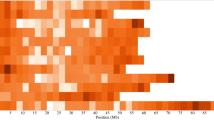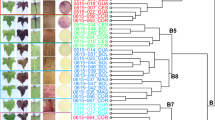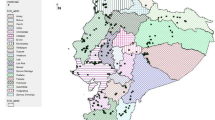Summary
A total of 25 potato isozymes were characterized by the numbers and relative mobilities of their allozymes, the subunit number, the subcellular localization, and the patterns of tissue expression. Using hierarchically ordered phenotype arrays at 9 of these isozymes, we were able to construct a dichotomous classification table for a total of 74 potato varieties, including those of most agronomical interest in Europe and North America.
Similar content being viewed by others
References
Almgard G, Clapham D (1975) Isozyme variation distinguishing 18Avena cultivars grown in Sweeden. Swed J Agric Res 5:61–67
Almgard G, Clapham D (1977) Swedish wheat cultivars distinguished by content of gliadins and isozymes. Swed J Agric Res 7:137–142
Bassiri A, Rouhani A (1977) Identification of broad bean cultivars based on isozymes. Euphytica 26:279–286
Brewer GJ (1970) An introduction to isozyme techniques. Academic Press, London New York
Brinkman FG, Van der Meer LJ (1975) Dehydrogenases in the potato tuber (S. tuberosum). Identity, coenzyme specificity, and isozyme composition of malic enzyme, malate dehydrogenase, and lactate dehydrogenase. Z Pflanzenphysiol 75:322–331
Desborough SL (1983) Potato (Solanum tuberosum L.). In: Tanksley SD, Orton TJ (eds) Isozymes in plant genetics and breeding, part B. Elsevier Science Publ, Amsterdam
Desborough S, Peloquin SJ (1968) Potato variety identification of electrophoretic patterns of tuber proteins and enzymes. Am Potato J 45:220–229
Fedak JG (1974) Allozymes as aids to Canadian barley cultivars identification. Euphytica 23:166–173
Fine IH, Costello LA (1963) The use of starch gel electrophoresis in dehydrogenase studies. In: Collowick SP, Kaplan NO (eds) Methods in enzymology, vol VI. Academic Press, London New York
Gottlieb LD (1973) Genetic control of glutamate oxaloacetate transaminase isozymes in the diploid plantStephanomeria exigua and its allotetraploid derivative. Biochem Genet 9:97–107
Kuhns LJ, Fretz TA (1978) Distinguishing rose cultivars by polyacrylamide gel electrophoresis. 2. Isozyme variation among cultivars. J Am Soc Hortic Sci 103:509–516
Martinez-Zapater JM, Oliver JL (1984a) Identification of potato varieties: an isozyme approach. In: D'Arcy WG (ed)Solanaceae: biology and systematics Columbia University Press, New York (in press)
Martinez-Zapater JM, Oliver JL (1984b). Genetic analysis of isozyme loci in tetraploid potatoes (Solanum tuberosum L.) Genetics (in press)
May B, Staub JE, Kuhns LJ (1982) Potato cultivars: genetic variation within putative clones. Am Potato J 59:179–184
Natarella NJ, Sink KC Jr (1975) Electrophoretic analysis of proteins and peroxidases of selectedPetunia cultivars. Bot Gaz 136:20–26
Oliver JL, Martinez-Zapater JM (1984) Allozyme variability and phylogenetic relationships in the cultivated potato. Plant Syst Evol (in press)
Pasteur N (1973) Microelectrophoretic analysis of enzymes an other proteins during development ofDrosophila pseudoobscura. University of Texas, Austin, PhD Dissertation
Philipp DP, Childers WF, Whitt GS (1979) Evolution of patterns of differential gene expression: a comparison of the temporal and spatial patterns of isozyme locus expression in two closely related fish species (northern largemouth bass,Micropterus salmoides salmoides, and smallmouth bass,Micropterus dolomieui). J Exp Zool 210:473–488
Rick CM, Fobes JF (1974) Association of an allozyme with nematode resistance. Rep Tomato Genet Crop 24:25
Rick CM, Zobel RW, Fobes JF (1974) Four peroxidase loci in red-fruited tomato species: genetics and geographic distribution. Proc Natl Acad Sci USA 71:835–839
Rickeman VS, Desborough SL (1978) Inheritance of three electrophoretically determined protein bands in potato (Solanum tuberosum L.). Theor Appl Genet 52:187–190
Roose ML, Gottlieb LD (1980) Alcohol dehydrogenase in the diploid plantStephanomeria exigua (Compositae): gene duplication mode of inheritance and linkage. Genetics 95:171–186
Salinas J, Pérez de la Vega M, Benito C (1982) Identification of hexaploid wheat cultivars based on isozyme patterns. J Sci Food Agric 33:221–226
Santamour FS Jr, Demuth P (1980) Identification of Callery pear cultivars by peroxidase isozyme patterns. J Hered 71:447–449
Selander RK, Smith MH, Yang SY, Johnson WE, Gentry JB (1971) Biochemical polymorphism and systematics in the genusPeromyscus. I. Variation in the old-field mouse (Peromyscus polionotus). Univ Texas Publ 7103:49–90
Shaw CR, Prasad R (1970) Starch gel electrophoresis of enzymes. A compilation of recipes. Biochem Genet 4:297–320
Staub JE, Kuhns LJ, Grim P, May B (1982) Stability of potato under different storage regimes. J Am Soc Hortic Sci 107:405–408
Stegemann H (1979) Characterization of proteins from potatoes and the “index of European potato varieties”. In: Hawkes JG, Lester RN, Skelding AD (eds) The biology and taxonomy of theSolanaceae. Academic Press, London New York
Stegemann H, Loeschcke V (1976) Index Europäischer Kartoffelsorten/Index of European potato varieties (bilingual), based on electrophoretic spectra. Mitt Biol Bundesanst Land- Forstwirtsch, Berlin-Dahlem 168:1–215
Valizadeh M (1977) Esterase and acid phosphatase polymorphism in the fig tree (Ficus carica L.). Biochem Genet 15:1037–1048
Valizadeh M, Rivals P, Valdeyron G (1977) Utilisation du polymorphisme proteique pour l'etude des varietes de figuier (Ficus carica). Acad Agric France: 647-655
Vallejos CE, Tanksley SD (1983) Segregation of isozyme markers and cold tolerance in an interspecific backcross of tomato. Theor Appl Genet 66:241–247
Weeden NF, Gottlieb LD (1980) The genetics of chloroplast enzymes. J Hered 71:392–396
Wehner DJ, Duich JM, Watschke TL (1976) Separation of Kentucky bluegrass cultivars using peroxidase isoenzymes banding patterns. Crop Sci 16:475–480
Werner DJ, Sink KC Jr (1977) Identification of poinsettia cultivars by electrophoretic analysis of proteins and peroxidases. J Hered 68:35–40
Whitt GS (1983) Isozymes as probes and participants in developmental and evolutionary genetics. In: Ratazzi MC, Scandalios JG, Whitt GS (eds) Isozymes: current topics in biological and medical research, vol 10. Alan R Liss, New York, pp 1–40
Wolfe WH (1976) Identification of grape varieties by isozyme banding patterns. Am J Viticult 272:68–73
Zamir D, Tanksley SD, Jones RA (1982) Haploid selection for low temperature tolerance of tomato pollen. Genetics 101:129–137
Author information
Authors and Affiliations
Additional information
Communicated by H. F. Linskens
Rights and permissions
About this article
Cite this article
Oliver, J.L., Martinez-Zapater, J.M. A genetic classification of potato cultivars based on allozyme patterns. Theoret. Appl. Genetics 69, 305–311 (1985). https://doi.org/10.1007/BF00662449
Received:
Accepted:
Issue Date:
DOI: https://doi.org/10.1007/BF00662449




